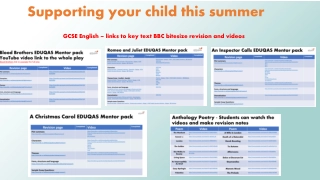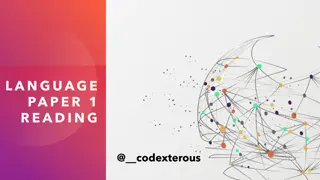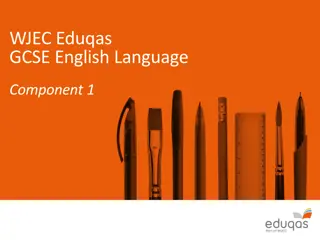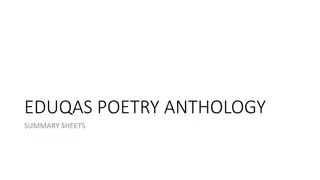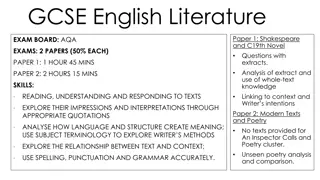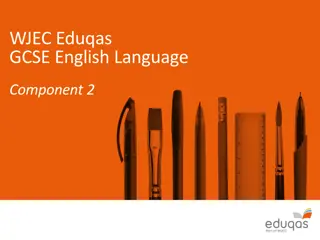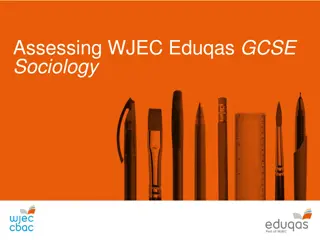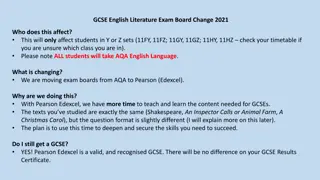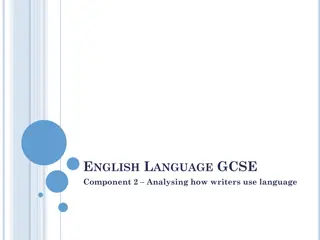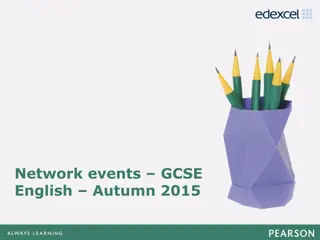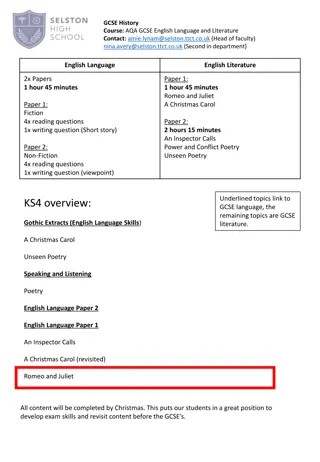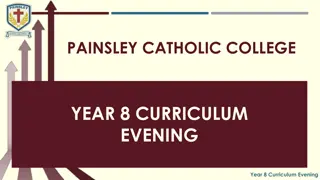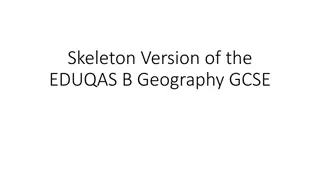Eduqas GCSE English Language Course Overview
The Eduqas GCSE English Language course focuses on text analysis, communication skills, and creative writing. The assessment objectives, key approaches, and marking criteria are outlined to guide both teachers and students in achieving success in the various components of the course.
Download Presentation

Please find below an Image/Link to download the presentation.
The content on the website is provided AS IS for your information and personal use only. It may not be sold, licensed, or shared on other websites without obtaining consent from the author. Download presentation by click this link. If you encounter any issues during the download, it is possible that the publisher has removed the file from their server.
E N D
Presentation Transcript
Eduqas GCSE English Language Information for new centres
Ethos The Eduqas GCSE English Language course is focused on how well students can understand texts written by others and how well they can communicate their own ideas. The focus is not on feature spotting and using techniques but is on clearly understanding meanings of texts and on clearly communicating meaning to others.
Specification Content in brief 20th Century Literature Reading and Creative Prose Writing Component 1 40% 1 hour 45 Section A: Reading One extract of 20th C prose (60-100 lines) with structured questions Section B: Writing One creative writing task from a choice of four titles (450-600 words) 40 marks 40 marks 19th and 21st Century Non-Fiction Reading and Transactional/Persuasive Writing Component 2 60% 2 hours Section A: Reading Two extracts of non-fiction (900-1200 words in total) with structured questions Section B: Writing Two compulsory writing tasks (300-400 words each) 40 marks 40 marks Component 3 Spoken Language Unweighted One presentation/speech, including responses to questions and feedback NEA (Non-exam assessment)
Assessment objectives The assessment objectives and their weightings are common across all exam boards. Assessment Objectives can be useful for teachers. However, there is no need for students to memorise them or to remember which AO applies to which question. If students read the questions properly and stick to the focus of the question they will be covering the AOs.
Key approaches Reading The most important consideration is for students to read, understand and then answer the question set. Students do not have to memorise formulas for answering different questions. The approach to all longer answer questions is the same and involves showing clear understanding of meanings, attitudes and the development of ideas. Writing Students should not base their writing around lists of techniques but should plan their answers based on the ideas they wish to communicate and make sure their writing is focused on the given task.
How the marking works For all except AO1 questions, each response is marked in five bands, with band 5 being the highest. Some of the key words in each band are shown below: Reading Writing Band 5 Perceptive, accurate, wide range Sophisticated, ambitious, convincing ideas Controlled, accurate, ambitious Consistent, well-judged, detailed ideas Secure Band 4 Accurate, good range Band 3 Relevant, some range Clear, appropriate, developed ideas Mostly secure Band 2 Some relevance, limited range Some awareness (purpose,audience), little development of ideas Some control Basic, limited ideas Limited control Band 1 Basic, struggles to engage
Reading questions: getting the basics right Read the question TWICE and identify the key focus Be precise and concise Don t spend too long on each question- it is roughly 10-12 minutes writing time for a 10 mark question Don t take individual words out of their specific context i.e. show how words are working to create meaning in the way they are used specifically in that text. For longer answer questions, TRACK the text and show RANGE of different facets/elements/ideas in response to the question focus Terminology or feature spotting should never drive responses- answers should lead with meaning
Reading questions: lead with meaning Rather than starting sentences like this: The writer uses the [technique/word class] to show They should begin more like this: We learn that [the character/event] feels/is
Reading questions: word class terminology Example 1: The writer uses the adverb fiercely to show Harry is angry about losing his market stall Example 2: We learn how passionate Harry is to continue working as the writer states directly that he is, fiercely determined to continue The first example uses terminology correctly but considers the word out of context. The second example is better as it shows clear understanding of the word being used in context. In other words, it is more important to show understanding of meaning than to label a word.
Writing questions: getting the basics right Read the tasks carefully and stay on task throughout Meet the minimum word count- know what this looks like in your own handwriting so that you don t need to count the words in the exam Plan briefly and use paragraphs to help structure and development of ideas Leave time to read over the writing and check it is clear (e.g. sentence construction) and consistent (e.g. tense, pronouns) and to correct basic errors in spelling and punctuation.
Sample questions The following slides use example questions from the November 2019 past papers. You can use the search facility to access all previous past papers and mark schemes. Looking at whole papers, you will see that all the reading questions are presented together on one page. The resource material is separate and students answer in a separate answer booklet.
Sample questions: Component 1 Section A Q1 01 Read lines 1-10. List five things you learn about the narrator in these lines. [5] Stick to the given lines Use bullet points and write concisely but with enough detail to be precise. Answers do not have to be in full sentences. Go for the most literal things first i.e. start with things we are actually told before moving on to anything more inferential (or in the words of the AOs, give the explicit before the implicit) Make sure each point is different i.e. avoid saying the same thing in two different ways Adding another point or two is fine if unsure of any but don t waste time
Sample questions: Component 1 Section A Q2, 3 and 4 02 Read lines 11-20. How does the writer show the narrator s thoughts and feelings in these lines? [5] You must refer to the language used in the text to support your answer, using relevant subject terminology where appropriate. 03 Read lines 21-61. What impressions does the writer create of the woman in these lines? [10] You must refer to the language used in the text to support your answer, using relevant subject terminology where appropriate. 04 Read lines 62-86. What are the narrator s thoughts and feelings in these lines? How does the writer show his thoughts and feelings? [10] You should write about: what happens in these lines the writer s use of language and structure You must refer to the text to support your answer, using relevant subject terminology where appropriate.
Component 1 Section A Q2, 3 and 4 You must refer to the language used in the text to support your answer, using relevant subject terminology where appropriate. This direction in italics is given under each question. It means: Students must quote/use evidence from the text to support their answers Terminology can be used where it helps make a point about meaning and not simply to label a word Subject terminology is broader than word classes and involves the bigger picture of narrative writing e.g. action, dialogue, turning point, narrator etc. It may help to think of it as the language that you use every day in English lessons and that is probably not being used in maths, science or geography for example. Terminology or feature spotting should not be the focus of an answer. Students should always lead with meaning .
Component 1 Section A Q2, 3 and 4 These questions focus on A02 and the question stems may include what impressions / what are [character s] thoughts and feelings / how does the writer show or similar ways of asking students to focus on meaning and how meaning is made. Read the question TWICE and identify the key focus Track the section of text chronologically to highlight key evidence and stay within the given lines Q 2 has fewer lines so there will be fewer points to make Write concisely. The basic needed for each idea is point & evidence . If the point is quite straightforward, no further analysis is needed. In other words, don t enforce a Point Evidence Explanation (or P E A analysis or P E C comment) paragraph if the final E, A or C simply repeat the point made. More perceptive points will usually need more explanation and development. More on this to follow. Students will need a range of evidence from across that section of text to get into the higher bands. They should have a range of different ideas/events/facets of character from across that section. More on this to follow. These students will also need to show some exploration or analysis of language within the context of the text.
Component 1 Section A Q2, 3 and 4 Focus and concise writing Example extract from response to Q2: The writer shows that the man is concerned about money I had eighty pounds to last me this shows that he has not much money to last him and he is concerned about money because he doesn t have much In this example, the explanation simply repeats the point made at the start. This is quite a straightforward point to make and needs no further explanation. The student could have moved on to give another example of the man s thoughts and feelings.
Component 1 Section A Q2, 3 and 4 Focus and concise writing- a good example Example extract from response to Q3: The writer also creates the impression that the woman is quite disrespectful, she added as though I had not spoken, which could show that she believes only her opinion is important. This is later reinforced when, she made her disapproval very clear, towards his food. In this example, the point is good ( she s disrespectful ), the explanation develops the idea rather than simply repeating it ( she believes only her opinion is important ), the evidence is well embedded and the student shows awareness of how this impression is building up ( later reinforced when ).
Component 1 Section A Q2, 3 and 4 Range Range means that students need to show understanding of different facets of character or relationships or events (the question focus) across the whole given section of text. Students will probably ask how many points they need to make for each question and this is difficult to answer for many reasons. The range of different points students make will depend on many things, for example: Reading/writing speed- slower readers and writers may be better advised to make a few straightforward points for each question and make sure they get through all the questions Target grade- students with a lower target grade will also be best advised making a smaller number of straightforward accurate, supported points while students with a high target grade should try to cover the whole of the given section and ensure a good range of different ideas across that section. The best students will have a wide range of perceptive points and their answer will have a strong sense of cohesion rather than being a series of disconnected ideas. These students will also need to show some exploration or analysis of language within the context of the text.
Component 1 Section A Q2, 3 and 4 Structure We do not have any questions that isolate structure. Instead, you will see that structure is included in one of the bullet points for either Q3 or Q4. What we are looking for here is that students understand how the writer has developed their ideas or shaped our response as the text progresses. If students follow the advice to track the text, they will be covering structure at least implicitly in their answers. A number of answers are written like this: The first impression of the woman is that .. The next impression I get is that she (and similar paragraph starters leading to ) By the end of the section I get the impression that the woman This kind of answer is generally solid and shows that students have tracked the text.
Component 1 Section A Q2, 3 and 4 Structure- a good example The best students may offer a more explicit understanding of how the writer has developed their ideas or shaped our response as the text progresses. For example (from Q4): At the start of this section, the narrator has a fear of embarrassment when panic seized him because it would be so embarrassing to not be able to afford the bill. We see the narrator s thought process as he comes up with the plan to leave his watch and pay later and this plan leads to a bit of relief when he says, I was past caring now. However, this does not last long because he is embarrassed again when he thinks the tip he is able to leave is too small and that the woman thinks he is mean . The final two lines are separated to show the change in time and act as a kind of moral to the story
Sample questions: Component 1 Section A Q5 05 To answer this question you must consider the passage as a whole. The writer has created an enjoyable short story with a satisfying ending. How far do you agree with this statement? [10] You should write about: your thoughts and feelings about the ending of the story and the story as a whole how the writer has created these thoughts and feelings You must refer to the text to support your answer.
Component 1 Section A Q5 This question is focused on A04 evaluation Read the question TWICE and identify the key focus It is most likely to follow the pattern: statement followed by how far do you agree? By now students have traced the events and character developments/journeys/learning through the text and should have a genuine view in response to the given statement. By the nature of the text being fiction, it is likely that there will be subtleties and that students may have different opinions in response to the statement. They should not force a balanced view - it may be perfectly possible to fully agree, fully disagree or see different sides depending upon the nature of the text and question. In other words, students shouldn t have a pre-prepared idea on how to approach this question. Once they have decided what they think about the statement, the process is the same as the other 10 mark questions: track through the text to find the best evidence to support that view. Questions assessing AO4 do not require students to use subject terminology. The focus is on the students clear, supported opinions.
Resources to support Component 1 Section A Component 1 Reading: Approaches and ideas 20th Century Literature Reading Resources 19th, 20th and 21st Century Texts
Sample questions: Component 1 Section B In this section you will be assessed for the quality of your creative prose writing skills. 24 marks are awarded for communication and organisation; 16 marks are awardedfor vocabulary, sentence structure, spelling and punctuation. You should aim to write about 450-600 words. Choose one of the following titles for your writing: [40] Either, 11 a) The Rebel Or, 11 b) Write about a time when you lost your temper Or, 11 c) The New Pet Or, 11 d) Write a story which ends: and it showed Alex that we always have a choice.
Component 1 Section B: approaches Students need to stick to the chosen title and make this clear from the start and throughout. They should know what 450-600 words looks like in their own writing. They have 45 minutes for this task and should spend the first 5 minutes choosing a task and making a brief plan so that they know where the storyline is heading. A coherent plot should be at the heart of their writing. If the reader is left scratching their head, it doesn t work or hang together properly- fancy vocabulary or techniques won t cover up a storyline that does not make sense. The writing needs to be plausible. This means that for some students, a realistic narrative based on personal experiences or knowledge is the best approach. More imaginative stories can work well for some students as long as they hold together and sustain the imagined world. Narratives should generally be limited to a small number of characters and a short time frame. The best narratives have a strong sense of narrative voice or characterisation. Ideas to support the teaching of narrative writing can be found here and classroom activities here both on the Eduqas Digital Educational Resources website
Component 2 Section A The challenge of this section is that students have to read two texts. There is no need for students to read both texts before starting- they can read the first text on the separate resource material and do questions 1 and 2 before moving on to the second text. As the texts share a common theme, a very small number of students use the wrong text for the given questions. They should check the instructions carefully to make sure they are using the correct text. Timings for the longer reading responses are the same as on Component 1- students have roughly 10-12 minutes to spend on a 10 mark answer. The way that students approach questions is the same as the way they have approached questions for Component 1. Tracking and Range are the key words to use and students must show clear understanding of the meanings of the texts and the writers attitudes. Re-reading questions to identify focus is crucial. Q4 in this particular past paper is a question where there are two linked areas of focus ( sights and sounds ) in the question.
Sample questions: Component 2 Section A Q1 and Q3 The extract on the opposite page is from a Victorian magazine, London As It Is . Read the newspaper article in the separate Resource Material. (a) Give one detail that suggests that Kingsland Road market used to be very busy. [1] (b) When did market trading begin at the Kingsland Road market? [1] (c) What does Harry West s grandson sell in the market? [1] These questions involve location and retrieval (AO1) Write concisely but with enough detail to be precise. Answers do not have to be in full sentences.
Sample questions: Component 2 Section A Q2 12 How does the writer try to show that Harry West is determined to continue working as a street seller? You should comment on: what is said the use of language, tone and structure other ways the writer tries to show that Harry West is determined to continue working as a street seller [10]
Component 2 Section A Q2 This question focuses on A02 and is asking students to focus on meaning and how meaning is made. The following advice is the same as that given for C1: Read the question TWICE and identify the key focus Track the text chronologically to highlight key evidence Write concisely. The basic needed for each idea is point & evidence . If the point is quite straightforward, no further analysis is needed. In other words, don t enforce a Point Evidence Explanation (or P E A analysis or P E C comment) paragraph if the final E, A or C simply repeat the point made. More perceptive points will usually need more explanation and development. Students will need a range of evidence from across the text to get into the higher bands. They should have a range of different ideas/events/facets of meaning from across that section. We are not looking for a checklist of persuasive features and as in Component 1, terminology needs to be meaningful and quotes need to be considered in their specific context.
Component 2 Section A Q2 Focus on the question and show range Example extract from response to Q2: The text goes on to say that West is a street seller through and through and he had even offered to meet the council to discuss how he can keep trading showing how important this is to him. In this example, there is clear focus on the question ( determined to continue working as a street seller ) and concise relevant quotes embedded. However, although the point made is good ( showing how important this is ) it is rather general. The student could have made two more specific points here, as on the next slide.
Component 2 Section A Q2 Focus on the question and show range- a good example Example extract developed: The text goes on to say that West is a street seller through and through showing that it is part of his life or even in his DNA so he is almost genetically driven to keep working as a street seller. He is also shown to be a reasonable man who is willing to negotiate as he offered to meet the council to discuss how he can keep trading In this example, using the same evidence, there are two very different facets of Harry s determination which show more perceptive understanding.
Component 2 Section A Q2 Using terminology and keeping things in context Example extract from Q2: The writer uses statistics like 40 years and 72 year old West to show how determined Harry is. In this example, the evidence is relevant but two statistics are taken out of their context and are not given a sense of meaning. Example extract developed: The text begins by telling us that Harry has been selling for 40 years giving a clear indication from the outset that Harry has dedicated a long part of his life to his career. The fact that he is called 72 year old West shows that he has continued working past the usual retirement age and must therefore really love the job.
Sample questions: Component 2 Section A Q4 14 The writer paints a vivid picture of the sights and sounds of Petticoat Lane Market. How far do you agree with this statement? You should comment on: what the writer says how the writer says it You must refer to the text to support your comments. [10]
Component 2 Section A Q4 The following advice is the same as that given for C1 Q5: Read the question TWICE and identify the key focus It is most likely to follow the pattern: statement followed by how far do you agree? By now students have traced the attitude/events through the second text and should have a genuine view in response to the given statement. By the nature of the text being non-fiction, it could be that there is a very clear attitude coming from the writer. The given statement will give students a way in to the text and enable them to select relevant details. Again, they should not force a balanced view . In other words, students shouldn t have a pre-prepared idea on how to approach this question. Once they have decided what they think about the statement, the process is the same as the other 10 mark questions: track through the text to find the best evidence to support that view. Questions assessing AO4 do not require students to use subject terminology. The focus is on the students clear, supported opinions. This question is focused on A04 evaluation in the second source text
Component 2 Section A Q4 Focus on the question Example extract from response to Q4: One reason I agree with the statement is the use of similes in a dozen pairs of eyes are upon us, like vultures and without being crunched like snails. The effect is the reader gets the idea of chaos yet enjoyment of the market. In this example, there are concise relevant quotes embedded (the focus being vivid picture of the sights and sounds ) but the feature spotting approach means that the meaning is not fully clear ( enjoyment ?) The student could have made two more specific points here, as on the next slide.
Component 2 Section A Q4 Focus on the question Example extract developed: There is a vivid sense of the sight of the market sellers being threatening in a dozen pairs of eyes are upon us, like vultures and the market itself is shown as chaotic in the vivid image of the shopper being crunched like snails. In this example, the student leads with meaning and therefore makes two distinct observations about the atmosphere of the market ( threatening and chaotic ) both of which are supported by relevant sights. The best students may summarise that the vivid sights are often shown as imagery in this text as it has a storytelling/narrative style.
Sample questions: Component 2 Section A Q5 15 Briefly explain in your own words what we learn about Petticoat Lane and the area around Kingsland Road. Do not give details about the markets themselves. [4] This question focuses on A01 synthesis and retrieval It is worth 4 marks so no longer than 4 or 5 minutes should be spent finding the details and writing the answers synthesis here involves finding the relevant details from each text and bringing them together into one answer Students should write in full sentences and may include direct quotation of relevant details from the text as part of the answer The key to this question is reading the question thoroughly and finding the correct part of the texts They should state clearly which text they are talking about and must cover both (only 1 text = only 1 mark even if more than 1 correct detail is given) They will be marked for the retrieval of accurate details from each text The most straightforward way to gain 4 marks here is to provide 2 accurate details from each named text (see mark scheme for further details)
Sample questions: Component 2 Section A Q6 15 Both of these texts are about markets and street sellers. Compare: the ways in which Harry West and the Petticoat Lane street sellers try to sell their goods how the writers show what these street sellers are like [10]
Component 2 Section A Q6 This question is focused on A03 comparison Read the question TWICE and identify the key focus It can be a mistake for students to think of this as the comparison question as sometimes that leads them to launch into a general comparison of anything in the texts The question focus will be clear and specific and may be slightly different in each of the bullet points so students must ensure they cover each bullet point Many of the available marks here are for the retrieval of correct details from the texts The best students will offer an overview and will give clear comparisons. Many students will give more implicit comparisons through considering each text in turn.
Resources to support Component 2 Section A Component 2 Reading: Approaches and ideas 19th and 21st Century Non-fiction texts 19th, 20th and 21st Century Texts
Sample questions: Component 2 Section B SECTION B: 40 marks Answer Question 21 and Question 22 . In this section you will be assessed for the quality of your writing skills. For each question, 12 marks are awarded for communication and organisation; 8 marks are awarded for vocabulary, sentence structure, punctuation and spelling. Think about the purpose and audience for your writing. You should aim to write about 300-400 words for each task. Two shorter tasks, with 30 minutes for each, means that students are less likely to run out of ideas for each task. As mentioned in the rubric above, the purpose and audience are important for these tasks. The word count is important and students should know what this looks like.
Sample questions: Component 2 Section B tasks 21 You have been asked to give a talk to your class with the title: The person I d most like to spend a day with. Your talk could be about a person who is famous such as a sportsperson, musician, inventor or national figure, someone from the past or someone who is not necessarily well known but who you admire. Write what you would say in your talk. [20]
Sample questions: Component 2 Section B tasks 22 A teenage magazine has invited readers to write articles on topics that people have strong views about. The latest topic is tattoos are they just harmless fun and fashion or something to regret in later life? You decide to write an article on the topic for the teenage magazine, giving your views. Write your article. [20]
Component 2 Section B: approaches Students need to identify the format, audience and purpose They should know what 300-450 words looks like in their own writing. They have 30 minutes for each task and should spend the first 5 minutes making a brief plan so that they are able to structure their writing effectively Development of ideas/opinions should be at the heart of their writing. If it is contradictory or doesn t hang together properly it won t be doing the job- fancy vocabulary or techniques won t cover up lack of clarity or development. Paragraphing is important to establish an idea (through the topic sentence) which is then developed through that paragraph e.g. with anecdotes, examples, evidence, suggestions. For many students, a good model is to have three main ideas forming the basis of three main body paragraphs. The writing needs to seem authentic- students should think, what would I really want to say to this audience? (rather than how can I use devices to impress the examiner? ) As on Component 1, the best pieces of writing have a strong sense of authorial voice. The best writing makes clear references to the audience Resources to support the teaching of this section can be found here
Component 3: Spoken language NEA This component is identical to that of the other exam boards. Students will complete one formal presentation or speech. They will also be assessed on their responses to questions and feedback following the presentation or speech. The assessment should take no longer than 10 minutes. Presentations must be formal but may take a wide variety of forms, including talks, debates, speeches and dialogues. Where the audience is the teacher only, the presentation and dialogue must be designed in such a way that it could have a potentially wider audience than just one person (e.g. it replicates a television interview). Students can use notes, Powerpoints etc if they wish. Standard English should be a feature of all parts of the students work in this component. This component assesses AO7, AO8 and AO9. Achievement will be reported as a separate grade (Pass, Merit, Distinction or Not Classified) and will not contribute to the 9-1 result of the GCSE English Language qualification. There is significant guidance and a number of supporting documents under the Spoken Language tab of the Key Documents under Resources on the Eduqas GCSE English Language pages
Teaching the course Because teachers of GCSE English work in varied scenarios, and may have to balance the demands of both Language and Literature courses, this specification is being delivered in many different ways by schools and colleges. For GCSE English Language, it is a good idea to link the skills of reading and writing explicitly. In other words, texts that are read should be used as models of good writing rather than simply used as texts from which to practise reading questions. The Guidance for Teachers has comprehensive advice and ideas for teaching. We also have resources with activities designed to show students how the skills they are developing apply to both Language and Literature. In Eduqas Digital Educational Resources, we have a number of resources including teaching guidance, suggested course plans and interactive activities for classroom use.
Using Online Exam Review (OER) to help your assessment OER allows you to look at student responses to past exam paper questions. You can view these as unmarked and marked. The statistical table shows you have many students answered each question, the mean mark for each question and how accessible that question was (the facility factor ). It can also be interesting to see the percentage attempt which indicates how many students didn t attempt particular questions and/or ran out of time. The left hand menu bar has a range of responses at different levels of achievement. There are instructions for accessing OER on the home screen.
Resources overview Guidance for teaching: starting point for activities, resources and advice to help plan the course Past papers and mark schemes Resources: including examiners reports, assessment grids, exemplar responses, grade boundaries, key dates, FAQs etc Digital resources for classroom use CPD materials from all previous CPD sessions Online exam review WJEC Secure website for your results data and access to additional NEA exemplars and guidance
Any Questions? Contact our specialist Subject Officers and administrative team for your subject with any queries. Nancy Hutt: Subject Officer Matt Oatley / Lewis Beecham: Subject Support Officers gcseenglish@eduqas.co.uk 029 2240 4288 @eduqas eduqas.co.uk









